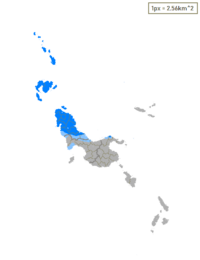Northern Ivili Language: Difference between revisions
mNo edit summary |
No edit summary |
||
| Line 20: | Line 20: | ||
| region = [[Flatstone|Şotīko Archipelago]] in [[Olivacia]] | | region = [[Flatstone|Şotīko Archipelago]] in [[Olivacia]] | ||
| ethnicity = Stonish | | ethnicity = Stonish | ||
| speakers = [https://en.wikipedia.org/wiki/First_language L1]: | | speakers = [https://en.wikipedia.org/wiki/First_language L1]: 4,500,000+ | ||
| speakers2 = [https://en.wikipedia.org/wiki/Second_language L2]: 4,335,000+<br>[https://en.wikipedia.org/wiki/Foreign_language FL]: 25,000+ | | speakers2 = [https://en.wikipedia.org/wiki/Second_language L2]: 4,335,000+<br>[https://en.wikipedia.org/wiki/Foreign_language FL]: 25,000+ | ||
| date = 2018 | | date = 2018 | ||
Revision as of 15:53, 10 June 2022
This article is incomplete because it is pending further input from participants, or it is a work-in-progress by one author. Please comment on this article's talk page to share your input, comments and questions. Note: To contribute to this article, you may need to seek help from the author(s) of this page. |
| Ivili | |
|---|---|
| Şotī Ekuşemīn | |
| Pronunciation | /aɪdʒaɪlaɪ/ |
| Native to | |
| Region | Şotīko Archipelago in Olivacia |
| Ethnicity | Stonish |
Native speakers | L1: 4,500,000+ (2018) L2: 4,335,000+ FL: 25,000+ |
| |
| Official status | |
Official language in | |
Recognised minority language in | |
| Language codes | |
| ISO 639-2 | IVL |
| ISO 639-3 | IVL |
| Linguasphere | TBA |
 Distribution of the language throughout Flatstone
Absolute majority >50% of native speakers | |
TBA
History
TBA
Geographic distribution
TBA
Classification
TBA
Regional variants
TBA
Phonology
Overview
Standard Ivili has traditionally operated under a Verb–subject–object word order (VSO), and this has been true for the entirety of the languages existence. It is also worth noting that in Ivili, Possession is typically ordered possessee before possessor. The Ivili language has five grammatical cases, and typically relies heavily on context to determine singularity, plurality, and depending on the sentence, tenses. Ivili has just seventeen phonemes, making the language the simplest of the four that are native to the Şotīko archipelago.
Alphabet
The transition from a Runic alphabet to a Latin script took place over the span of roughly a decade, likely beginning sometime in the mid nineteenth century. However, the Latin script wouldn't be officially adopted by the Kingdom of Flatstone until 1911, when it was standardized. Despite this, the Latin alphabet had risen in popularity on it's own, first being used en masse by the merchant class of Flatstone at the turn of the 19th century, and being spread through relatives via letters, newspaper articles, etc. Today, the Ivili alphabet consists of fifteen letters:
| Ā ā | B b | K k | D d | E e | G g | Ī ī | J j |
| L l | M m | N n | O o | P p | Ş ş | U u |
It should also be mentioned that there are adaptations of the standard Ivili alphabet (Most notably the Southern Ivili language) that include the voiced dental fricative ("ð"), the voiceless alveolar plosive ("t"), and the voiced labiodental fricative ("v") to compensate for the fact that some regional accents replace the pronunciation for the letter "J" in the Ivili alphabet with either of these three phonemes. However, this addition to the alphabet isn't federally standardized and is only recognized by a few localities.
| Order | 1 | 2 | 3 | 4 | 5 | 6 | 7 | 8 | 9 | 10 | 11 | 12 | 13 | 14 | 15 |
|---|---|---|---|---|---|---|---|---|---|---|---|---|---|---|---|
| Majuscule | Ā | B | K | D | E | G | Ī | J | L | M | N | O | P | Ş | U |
| Minuscule | ā | b | k | d | e | g | ī | j | l | m | n | o | p | ş | u |
| IPA Sound | e͡i | b | k | d | e | a͡i | g | j | l | m | n | o | p | ʃ | u |
Phonetics
| Labial | Coronal | Dorsal | Laryngeal | |||||||||||||||||||||
|---|---|---|---|---|---|---|---|---|---|---|---|---|---|---|---|---|---|---|---|---|---|---|---|---|
| Bilabial | Labiodental | Linguolabial | Dental | Alveolar | Postal-veolar | Retroflex | Palatal | Velar | Uvular | Pharyngeal | Glottal | |||||||||||||
| Nasal | m (m) |
n (n) |
||||||||||||||||||||||
| Plosive | p (p) |
b (b) |
t (t) |
d (d) |
k (k) |
g (g) |
||||||||||||||||||
| Sibilant affricate | ||||||||||||||||||||||||
| Sibilant fricative | s (s) |
ʃ (ш) |
||||||||||||||||||||||
| Non-sibilant fricative | ||||||||||||||||||||||||
| Approximant | j (j) |
|||||||||||||||||||||||
| Tap/Flap | ||||||||||||||||||||||||
| Trill | ||||||||||||||||||||||||
| Latelar approximant | l (l) |
|||||||||||||||||||||||
| Tongue position | Front | Near-front | Central | Near-back | Back | |||||
|---|---|---|---|---|---|---|---|---|---|---|
| Close | u (u) | |||||||||
| Near-close | ||||||||||
| Close-mid | e (є) |
o (o) | ||||||||
| Mid | ||||||||||
| Open-mid | ||||||||||
| Near-open | ||||||||||
| Open | ||||||||||
| Diphthong | e͡i (ei) ~ a͡i (ai) | |||||||||
